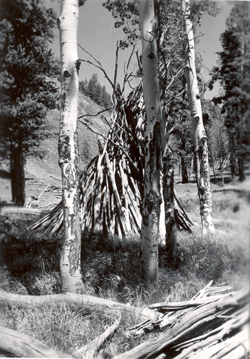 |
| A Shoshone wickiup. Image from explorebigsky.com |
Wednesday, February 20, 2013
J. L. Campbell’s Guide to Idaho
J. L. Campbell’s travel guide to the Territory of Idaho, Idaho: Six Months in the New Gold Regions, was intended to aid would-be emigrants contemplating a journey to the new gold fields. Campbell traveled the region in 1863, but by 1864 when his guide was published, it was already outdated. Montana Territory had been carved out of the vast chunk of Idaho. Campbell’s guide, however, was a useful tool because it described the route from Omaha, Nebraska, to the diggings at Bannack and Virginia City. Campbell offers advice, suggests items to take on the journey, and lists good campsites. His description of the Bannack mines includes a fascinating historical tidbit. He claims that he saw an ancient mine shaft where the miners presumably dug down to gold. A large pine tree, one foot in diameter, had grown in the mine shaft, attesting to the age of the mine. A couple of ancient timber huts stood nearby. Campbell noted that in the dry climate, timber exposed to weather could last a very long time. He theorized that the mines were the work of Spaniards who came north from Mexico exploring in the 1700s as some chronicles suggest. Most modern historians agree, however, that Spanish explorers did not venture this far north. A more likely explanation for this anomaly is that the mine was a stone quarry where Native Americans dug for chert to make weapons.
Certainly the timber huts are Native American wickiups, not shelters of Spanish origin. These temporary shelters do survive to great age and—along with tipi rings, rock cairns, and other manmade features—are part of Montana’s archaeological record.
Subscribe to:
Post Comments (Atom)
On Page 35 is a drawing of the first gold mill in Montana!
ReplyDeletePossibly the place Campbell is referring to as showing old gold diggings is where Dyce Creek joins Grasshopper. It's the only place along Grasshopper to the NW that has significant gold. It doesn't quite fit on the distance as it's only about 6 miles out as the crow flies, but perhaps is a better fit as the pack horse wanders! This would be a place to look for a chert quarry, or perhaps an old Spanish shaft with a tree or stump in it :)
ReplyDeleteJust want you to know I am thankful for this explanation- the link to the book helped me a lot with research. As far as I can tell, yours is the only mention of this book anywhere online. I found a reference to this book in a newspaper article but didn't know the name, besides that it was an 1860s guide to Idaho and was written by Campbell.
ReplyDelete